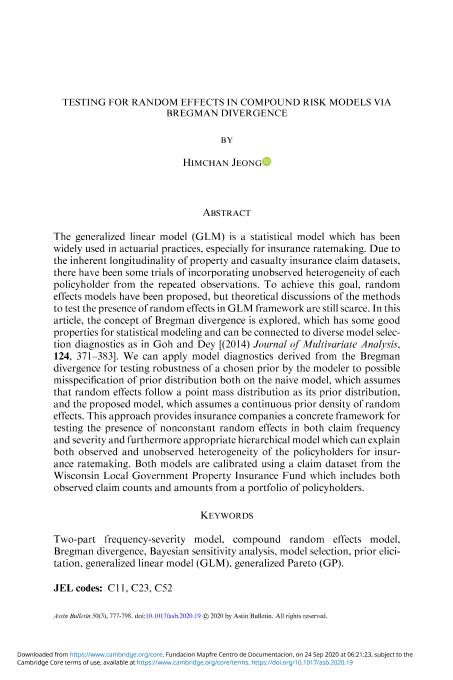Testing for random effects in compound risk models via bregman divergence

Contenido multimedia no disponible por derechos de autor o por acceso restringido. Contacte con la institución para más información.
| Tag | 1 | 2 | Valor |
|---|---|---|---|
| LDR | 00000cab a2200000 4500 | ||
| 001 | MAP20200029731 | ||
| 003 | MAP | ||
| 005 | 20200924174644.0 | ||
| 008 | 200924e20200901bel|||p |0|||b|eng d | ||
| 040 | $aMAP$bspa$dMAP | ||
| 084 | $a6 | ||
| 100 | $0MAPA20200019107$aJeong, Himchan | ||
| 245 | 1 | 0 | $aTesting for random effects in compound risk models via bregman divergence$cHimchan Jeong |
| 520 | $aThe generalized linear model (GLM) is a statistical model which has been widely used in actuarial practices, especially for insurance ratemaking. Due to the inherent longitudinality of property and casualty insurance claim datasets, there have been some trials of incorporating unobserved heterogeneity of each policyholder from the repeated observations. To achieve this goal, random effects models have been proposed, but theoretical discussions of the methods to test the presence of random effects in GLMframework are still scarce. In this article, the concept of Bregman divergence is explored, which has some good properties for statistical modeling and can be connected to diverse model selection diagnostics as in Goh and Dey [(2014) Journal of Multivariate Analysis, 124, 371383]. We can apply model diagnostics derived from the Bregman divergence for testing robustness of a chosen prior by the modeler to possible misspecification of prior distribution both on the naive model, which assumes that random effects follow a point mass distribution as its prior distribution, and the proposed model, which assumes a continuous prior density of random effects. This approach provides insurance companies a concrete framework for testing the presence of nonconstant random effects in both claim frequency and severity and furthermore appropriate hierarchical model which can explain both observed and unobserved heterogeneity of the policyholders for insurance ratemaking. Both models are calibrated using a claim dataset from the Wisconsin Local Government Property Insurance Fund which includes both observed claim counts and amounts from a portfolio of policyholders. | ||
| 650 | 4 | $0MAPA20160001679$aModelos lineales generalizados | |
| 650 | 4 | $0MAPA20080579258$aCálculo actuarial | |
| 650 | 4 | $0MAPA20080592011$aModelos actuariales | |
| 650 | 4 | $0MAPA20080597733$aModelos estadísticos | |
| 650 | 4 | $0MAPA20080578350$aTarifa de primas | |
| 773 | 0 | $wMAP20077000420$tAstin bulletin$dBelgium : ASTIN and AFIR Sections of the International Actuarial Association$x0515-0361$g01/09/2020 Volumen 50 Número 3 - septiembre 2020 , p. 777-798 |

